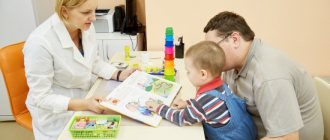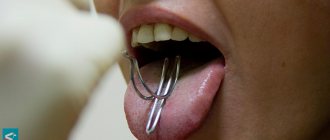What do we mean by speech impairment? The question requires thought, because it is not so easy to decide what is considered speech and at what age speech should be formed in a child. Scientists studying communications have come to the conclusion that many animals can communicate with each other. Dolphins, dogs, and primates have their own language. But speech as a means of verbal communication is accessible only to humans. Of course, provided that he is used to communicating from a very early age. To prevent you from growing up Mowgli, help your child develop speech! Should we sound the alarm if a 2-year-old child cannot construct a coherent sentence or is this normal for his age? But your parents tell you that you are his age... And your friend’s son already tirelessly chats with his parents all day long. How to understand where are individual norms and where are deviations and disorders of speech development? We will talk about this below.
Stages of development and formation of speech in a child
The skills and inclinations of a normally developing child directly depend on his age. But even in infants, experts are able to predict speech disorders in the future based on some signs. If motor development in the first year of life lags behind the norm, this is a possible sign that speech and mental development will also lag behind. We would also like to note that development standards were established in Soviet times and were quite strict. Now, unfortunately, many modern children do not meet them. Children of the new generation speak less and their speech takes longer to develop. The reasons for this are global “gadgetization” and the transition of people to virtual methods of communication.
| Age | Skills |
| up to 6 months |
|
| 6-9 months |
|
| 9 months-1 year |
|
| 1-1.5 years |
|
| 1.5-2 years |
|
| 2-3 years |
|
| 3-5 years |
|
Experts recommend regular examinations to identify delays, if any, as early as possible. One child is one of those who “harnesses slowly and rushes quickly.” He will start speaking later, but within a month he will catch up and surpass his peers. Then consider yourself lucky. But for another child, prolonged silence may hide such gloomy diagnoses as autism spectrum disorder, alalia and others. And it is very important not to miss them and start correction on time.
If you have any doubts about whether your child’s development rate is within the normal range, it is better to visit a specialist. What if he has a general
speech disorder
(general speech underdevelopment - GSD) or delayed speech development (SDD)?
For a child with severe speech impairment
It is often difficult to perceive the world around us positively. He grows up as a gloomy beech, touchy and aggressive, feels insecure, and with age begins to feel his inferiority. You can read more about the symptoms and degrees of speech underdevelopment here. Consult with specialists! Both minor and more significant speech deviations are usually identified in the first few years of life as a result of comprehensive diagnostics.
The spheres and areas of responsibility of specialists in speech problems are distributed as follows:
- Speech therapist
: Consults from 1.5 years old, conducts classes from 2 years old. At the consultation, he makes a final diagnosis, if it is a disease, and refers to a neurologist if there are suspicions of disorders of a corresponding nature; - Speech pathologist
: works with non-speaking children; in case of delays in psycho-speech development and pre-speech diseases (alalia, autism spectrum disorder), it helps to “start” speech and develop other cognitive functions to the level of the age norm.
We are primarily talking about young children. also occur in adults
- due to a brain injury or stroke.
Their correction is carried out by speech therapists and aphasiologists. Sometimes speech impairment in schoolchildren
and adults remains from neglected/undertreated pronunciation defects in childhood.
What are the symptoms of speech delay?
Parents should watch for possible signs of speech delays:
- Too quiet baby who only babbles a little
- history of ear infections
- limited number of consonants used
- the child does not connect thoughts and actions during play
- the child does not imitate (copy) words
- uses mostly nouns (names of people, places, things) and a few verbs (action words)
- does not play difficult games with peers
- uses mostly gestures to communicate
Types of speech disorders in children and adults
In speech therapy, several basic typifications are accepted - based on similar manifestations and sources. This helps to understand in which direction to look for the source of the problem and ways to correct speech impairment. Clinical and pedagogical classification
- Rhythm and tempo disorders: Stuttering (a deviation known since time immemorial. According to historians, the ancient Greek orator Demosthenes once suffered from a stutter, but persistently practiced making speeches by stuffing his mouth with small pebbles. Having learned to speak clearly with stones in his mouth, he developed an excellent articulation and self-confidence, thereby getting rid of the disease. Speech therapists still practice this method of correcting speech disorders).
- Dyslalia (in oral speech the child incorrectly pronounces or distorts individual sounds).
- Dysarthria (organs of articulation (lips, tongue) have critical limitations in mobility).
- Rhinolalia (reduced resonance in the nasal cavity).
- Other articulation disorders: polternium, tachylalia, bradyllalia.
- Aphonia (loss of a clear voice, a person speaks in a whisper. Problem with the vocal cords).
- Structural-semantic disorders: alalia (occurs during childbirth when the speech areas of the brain are damaged. At the same time, the child is fine with intelligence and hearing), aphasia (a similar problem. Organic lesions of the areas of the cerebral cortex that are responsible for controlling speech , and the adjacent “subcortex". It differs from alalia in that it is not a congenital phenomenon, but an acquired one - in people who can already speak. Usually occurs as a result of a stroke in adults).
- Dyslexia (difficulty perceiving written text, mixing sounds and words when reading, inability to form letters into ready-made words).
Psychological and pedagogical classification of speech disorders
- violations in the use of communication means stuttering
- other complications
- phonetic-phonemic speech underdevelopment
Main signs of ZRR
Parents may notice the first symptoms of RDD when their baby is not yet 2 years old. Unless he speaks in two-word phrases (for example, “Mom, give me”). If your son or daughter is 3 years old, pay attention to whether he speaks coherently, whether he speaks all the syllables of words, whether he uses a lot of words and whether they are enough for him to express his thoughts and desires.
If you see that your baby clearly lacks words, this may indicate a delay in speech development. If there really are problems, then at 4 years old they are obvious.
Causes of speech impairment in children
The deviation can be congenital or acquired, physiological or purely psychological. The choice of correction method directly depends on this. Once upon a time, ideas about the sources of speech anomalies were quite chaotic. Professor Mikhail Khvattsev, one of the pioneers in speech therapy among our compatriots, made a major contribution to the systematization of the causes. He divided them into internal and external and introduced the following classification:
- organic (anatomical-physiological, morphological): organic central (brain lesions);
- organic peripheral (defects of hearing or articulation, cleft palate, dental defects);
- functional (psychogenic - problems with excitation and inhibition in the central nervous system);
Trouble does not come alone; problems on any front will inevitably grow into a whole bunch of accompanying complications. Khvattsev emphasized the close connection between organic and functional causes. If the sensory organs do not work properly, natural reflexes are poorly established. And vice versa, if there are already problems of a functional nature, then the development of organs will also slow down. Like the affected central nervous system, it does not contribute to the development of the periphery.
Depending on the stage at which the basis for speech dysfunctions arose, they are divided into:
- hereditary. Unfortunately, we do not always inherit a strong body from our parents. Children get many troubles “as a gift”, sometimes it is stuttering, various disorders of the speech zones in the cerebral cortex, problems with bite or the wrong number of teeth, defects in the palate, anomalies in the structure of the organs of articulation.
- congenital (intrauterine). Caused by complications during pregnancy. If a woman works in a hazardous industry, delays maternity leave until the last minute or unsuccessfully tries to terminate a pregnancy, if the embryo is forced to drink alcohol, tobacco and strong drugs with the mother, then all this will never benefit the baby. The first trimester is especially important, when the central nervous system is formed in the fetus.
- perinatal (birth) and postnatal (appear soon after birth). They arise due to complications during the very birth of the baby, due to premature birth, as a result of birth injuries, etc.
- others (manifest in the first years of a child’s life and later). Here the root of evil is either psychological, social and everyday factors, or serious illnesses (meningitis and other dangerous infections, diseases of the hearing organs, injuries to the brain and speech organs).
Please note: the risks to which a fetus is exposed at different stages of its development before birth, and an independent person after birth, are not the same. Obvious tips that mothers sometimes neglect:
- during pregnancy, take care of yourself more than usual, avoid injuries, shocks and the use of harmful substances;
- carefully choose a maternity hospital with modern equipment and skilled midwives;
- after birth, do not develop sores, even small ones, remember how vulnerable the fragile organism of a little man who has just come into this world is.
Speech impairment in a child. Causes of speech impairment in a child
The main causes of speech development disorders
The speech function, as well as other higher mental functions (memory, thinking, perception, attention, etc.), is formed in a child gradually, starting from the prenatal period, and this process does not always proceed smoothly.
Deviations in speech development are possible for various reasons. These can be various pathologies during the period of intrauterine development (the most severe speech defects occur when exposed to unfavorable factors for a period of 4 weeks to 4 months of pregnancy), toxicosis, incompatibility of the blood of mother and child according to the Rh factor, viral and endocrine diseases, injuries, hereditary factors, etc.
The cause for concern may be birth trauma and asphyxia during childbirth, pathological course of childbirth, various diseases in the first years of a child’s life (skull injuries accompanied by concussion, etc.). Not least important are unfavorable social and living conditions, leading to children’s pedagogical neglect, disturbances in their emotional-volitional sphere and a deficit in verbal communication.
Parents need to pay attention to the child’s development of the need to speak. Often, when communicating with a small child, adults try to understand and fulfill his requests, without waiting for him to try to express them.
Depending on the duration of exposure to unfavorable factors and which part of the brain is damaged, speech defects of various types occur. Problems with speech can be just one of the manifestations of a general disorder of the nervous system and be accompanied by intellectual and motor impairment.
Currently, speech disorders have been studied very well and many of them are successfully corrected. The main thing is to contact a specialist in time in order to diagnose them in a timely manner and understand: speech impairment is the only problem or is it a consequence of other serious diseases (autism, hearing impairment, central nervous system function, deviations in intellectual development, etc.).
For parents concerned about a child’s speech delay or impairment, it is very difficult to understand how serious their child’s problem is and what needs to be done. As a rule, they hope that everything will go away on its own and waste precious time.
Main types of speech disorders
Speech disorders can be divided into four main types:
• violation of sound pronunciation;
• violation of the rhythm and tempo of speech;
• speech disorders associated with hearing impairment;
• underdevelopment of speech or loss of previously existing speech.
Violation of sound pronunciation
The most common disorder of sound pronunciation is dyslalia, in which there is either the absence of some sounds (the child misses them in words), or their distortion (the child pronounces them incorrectly), or the replacement of one sound with another.
Dyslalia can be functional or mechanical.
With functional dyslalia, there are no disturbances in the structure of the speech apparatus (jaws, teeth, palate, tongue). It is observed during the period when the process of assimilation of sounds occurs. Functional dyslalia can occur due to the general physical weakness of the child due to various somatic diseases (especially during the period of active speech formation), mental retardation (minimal brain dysfunction), delayed speech development, impaired phonemic perception, limited communication, and imitation of incorrect speech. In this case, it is necessary to develop the ability to listen to sounds and actively communicate with the child. Gymnastics can be effective to strengthen the muscles of the tongue.
With mechanical dyslalia, a violation of sound pronunciation is caused by anatomical defects of the organs of articulation, such as irregular teeth structure, absence of incisors or their anomalies, bite defects, pathological changes in the tongue (too large or too small tongue), shortened frenulum.
Sound pronunciation disorders caused by labial anomalies are less common, since congenital defects (deformations) are corrected surgically at an early age. If there are anatomical defects, consultation (and in some cases treatment) of a surgeon and orthodontist is necessary.
Dyslalia can also develop when communicating with children who have not formed the correct sound pronunciation. Being in a bilingual environment has an influence, as well as the attitude of adults towards incorrect pronunciation (many of them do not correct the child’s speech, believing that after some time he himself will learn to speak correctly).
Defects in sound pronunciation in children can be caused by underdevelopment of phonemic hearing (it is difficult for a child to distinguish sounds that are similar in acoustic characteristics: sh-zh, s-z, etc.), decreased physical hearing, and insufficient mental development.
But it is necessary to distinguish complex dyslalia from other similar disorders, in which lateral pronunciation of many phonemes may be observed, the appearance of excess saliva at the time of speech is noted, it is difficult for the child to hold the tongue in the desired position for a long time, the mobility of the tongue, the strength and accuracy of movements are changed.
A more serious disorder of sound pronunciation, resulting from organic damage to the central nervous system, is dysarthria. With dysarthria, not only the pronunciation of individual sounds suffers. Such children have limited mobility of speech and facial muscles. The speech exhibits fuzzy, blurred sound pronunciation, the voice is quiet, weak, and sometimes, on the contrary, harsh; the breathing rhythm is disturbed, speech loses its smoothness, the pace of speech can be accelerated or slowed down.
The causes of dysarthria are various unfavorable factors that can affect in utero during pregnancy (viral infections, toxicosis, pathology of the placenta), at the time of birth (prolonged or rapid labor causing hemorrhage in the baby’s brain) and at an early age (infectious diseases of the brain and brain). membranes: meningitis, meningoencephalitis, etc.).
This disorder can be observed in a severe form (as part of cerebral palsy), or in a mild, so-called erased form of dysarthria (dysarthric component). Children with this diagnosis receive comprehensive speech therapy and medical care in special institutions. In a milder form, disturbances in the movements of the organs of the articulatory apparatus, general and fine motor skills, as well as sound pronunciation can be traced - speech is understandable to others, but unclear.
Children with erased forms of dysarthria do not always immediately attract attention, but they can be distinguished by certain features. They slur their words, eat poorly, refuse to chew solid food because it is difficult for them to do so (such children must be gradually taught to chew solid food - this will contribute to the development of the muscles of the tongue and cheeks). Many skills that require precise movements of different muscle groups are difficult and need to be developed. A child’s education is carried out in different areas: the development of motor skills (general, fine, articulation), correction of sound pronunciation, formation of the rhythmic and melodic side of speech and improvement of diction.
Your baby needs to learn how to rinse his mouth. To do this, you must first learn to puff out your cheeks and hold the air, and then move it from one cheek to the other; suck in your cheeks, while your mouth is open and your lips are closed.
It is necessary to develop fine motor skills of the hands using special exercises. It is necessary to teach the child to fasten buttons (first large, then small) on the doll’s clothes or on a removed dress or coat. At the same time, the adult not only shows the movements, but also helps to make them with the hands of the child himself. To train the ability to lace shoes, various lacing aids are used.
Children with this disorder experience difficulties in visual activities. Therefore, it is necessary to teach them to hold a pencil correctly, regulate the pressure when drawing, and use scissors.
Difficulties are also noted when performing physical exercises and dancing. Children are taught to maintain balance, stand and jump on one leg, correlate their movements with the beginning and end of a musical phrase, and change the nature of movements according to the beat. Parents need to know that if correctional work is not started on time, this can later lead to reading (dyslexia) and writing (dysgraphia) disorders. To achieve results as quickly as possible, the work should be carried out together with a speech therapist; consultations with a psychoneurologist and a specialist in physical therapy are also necessary.
I would like to dwell on one more speech sound pronunciation disorder - rhinolalia, the main difference of which is the presence of a nasal tone in the voice. A nasal tone of speech (nasality) occurs when the stream of exhaled air passes almost entirely through the nose. In this case, sound production is disrupted, which depends both on the activity of the muscles of the soft palate, pharynx and tongue, and on the deformation of the hard palate (cleft), alveolar process, incorrect placement of teeth (in the presence of a cleft lip), and on the violation of the shape of the wing of the nose (nostrils).
The occurrence of clefts is influenced by genetic factors - unfavorable heredity (the presence of clefts in direct or indirect relatives); biological - maternal diseases during pregnancy (influenza, ARVI, mumps, toxoplasmosis); chemical - contact with harmful substances (pesticides, acids); poor environmental conditions; influence of alcohol, nicotine, drugs; uncontrolled use of medications, in particular oversaturation of the fetal body with vitamin A and drugs of the cortisone group.
Usually, this disorder is corrected at an early age through surgery. Basically, speech therapy classes begin immediately after plastic surgery of the palate.
Violation of the rhythm and tempo of speech
Let us dwell on one of the most common types of disturbances in the rhythm and tempo of speech - stuttering. This disorder is characterized by convulsive spasms of the speech muscles. It manifests itself in two forms - the so-called developmental stuttering and reactive stuttering.
Developmental stuttering is usually noted in early childhood, when the child does not speak well enough and has poorly formed articulation of the tongue, lips and cheeks. And if during this period the baby is taught to pronounce difficult words (frying pan, snowman, policeman, etc.), he may begin to stutter.
The basis for the occurrence of such stuttering is overexcitation of the speech areas of the brain. Therefore, the first measure aimed at restoring normal speech should be a “silence regime” for 7-10 days. We must try to exclude all types of emotional influence, completely limit the child’s speech, communicate in a whisper and reduce conversations with the baby to a minimum. Sometimes this helps, but in some cases the disorder is quite persistent.
As soon as a child develops a stutter or something similar to it (it is difficult for the child to start speaking, he finds it difficult to pronounce complex words, repeats the same syllable, etc.), you need to contact a speech therapist and strictly follow all his instructions.
Reactive stuttering (develops as a reaction to some strong influence) is most often the result of fear, mental trauma (severe conflicts in the family) or debilitating long-term illnesses.
Children with a weakened nervous system who have a predisposition to this speech disorder (stuttering in close relatives) begin to stutter. Such children often show signs of a neurotic state: poor appetite, restless sleep, night terrors, urinary incontinence, etc.
A child who stutters must be under the supervision of a neurologist. He needs both medical and speech therapy help. The main thing is not to fix the baby’s attention on this defect, not to imitate him and not to repeat incorrectly pronounced words after him. Your task is to teach him to speak more slowly. Most likely, the child is in a hurry not only to speak, so it is necessary to normalize the baby’s entire motor mode using calm games. The atmosphere in the family should also be smooth and calm.
Parents need to remember that if a child is easily excitable, whiny, sleeps restlessly, etc., they should not read to him too much, tell him long tales, or rush to teach him difficult words and complex phrases. This especially applies to children who have speech impairments that are acceptable for a given age. Against the background of untrained articulation, an abundance of new words will easily lead to a “disruption” of nervous activity. In other words, the level of speech development should correspond to the level of development of the baby as a whole. When this does not happen, there is a risk of stuttering.
It should be kept in mind that stuttering may recur after treatment. There are age periods in which the onset of the disease or its recurrence is most likely (from 2 to 6 years). The reasons for relapse are the same as the reasons that originally caused stuttering: conflicts in the family, overwork, infections that weaken the body. Consequently, the recurrence of stuttering can be prevented if people around them try to create a calm environment for the child.
Speech disorders associated with hearing loss
Already in the first year of life, you can draw your own conclusions about the level of speech development of the child. You should pay attention to the noise. If at 3-4 months it does not become more complicated and does not turn into babbling, but gradually fades away, this may indicate serious hearing impairment. As soon as possible, you need to examine the child’s hearing, contact an otolaryngologist, and have an audiogram done.
How to test your child's hearing at home?
The simplest method of testing hearing is to study it using whispered and ordinary conversational speech. Being at a distance of 5-6 meters from the baby (his back is to you), whisper words that are well known to him. Children with full hearing usually hear whispers. If the child cannot hear at such a distance, you need to gradually approach him until he can repeat all the words you said.
During the examination, it is necessary to take into account the general condition of the baby: fatigue, attention, readiness to complete the task. A tired child is easily distracted, does not perceive the meaning of the task assigned to him, and may give inaccurate answers. In the case when the baby does not yet speak oral language and does not understand verbal instructions, you can use sounding (tambourine, whistle) and voiced (bird, barking dog, etc.) toys.
If the child does not hear the whisper, move away from him at the same distance and say other words familiar to him in a voice at normal conversational volume. This method makes it possible to determine at what distance the baby hears normal speech. If you suspect that he has difficulty hearing, you should consult an otolaryngologist. If a young child hears speech at normal conversational volume at a distance of 3-4 meters (that is, physical hearing is normal), his speech development can be helped at home (19).
In case of hearing impairment, early corrective work has the greatest positive effect. If a hearing aid is indicated for your child, it must be used - with the help of the device, speech will be able to develop quite successfully. You need to talk to your baby slowly, so that he has the opportunity to see your face, facial expressions, articulation while you pronounce words - this will develop the ability to read lips.
Speech underdevelopment or loss of previously existing speech
There is a violation of speech activity - alalia, which can occur as a result of late maturation of nerve cells in the speech zone of the left hemisphere or as a result of early damage to these cells due to infections, intoxications, birth injuries, shortly after birth. There is motor alalia, when the child’s speech is poorly developed, and sensory alalia, when understanding the speech of other people is impaired. The most common form of alalia is a mixed form with a predominance of motor or sensory disorders. The speech of children suffering from alalia develops late, their vocabulary is replenished slowly, they do not change words according to numbers, cases, there are no connections of words in the sentence, so at 7-8 years old the child speaks like a 2-3-year-old child (“Katya is walking in kindergarten” ). It is difficult for them to pronounce sounds in a sequence, so they read poorly and do not understand what they read well. In such children, both general motor skills are insufficiently developed (they are inactive, awkward, slow) and finger movements.
With this diagnosis, logorhythmic exercises and exercises for the development of finely coordinated hand movements are very effective (we give examples of such tasks below). Not only a speech therapist, but also a psychologist, defectologist, psychoneurologist and other specialists (physical therapy, massage) should take part in working with such children.
If speech was already formed, but was lost due to focal damage to the speech areas of the brain, then we can talk about another speech disorder - aphasia. Even a very severe form of this disorder goes away relatively quickly in children if the main cause of the speech disorder is eliminated - a brain tumor is removed, hemorrhage after an injury has resolved, etc.
An important part of correctional work with non-speaking children are games and exercises aimed at improving the movements of the organs of the articulatory apparatus, relieving their muscle tension, and developing the ability to feel and control their movements.
In relation to young children (up to 5 years old), who master speech skills at a later date, specialists often use the diagnosis of SRD (speech development delay). This diagnosis can be made either independently or as a sign of some serious disorder. To understand this, you need to have an idea of the age-related characteristics of speech development, which will be discussed further.
When to seek professional help
By the end of the first year of life, with intact hearing, the child begins to develop understanding of speech. If this does not happen, that is, the baby does not engage in the work of imitating the actions and speech of adults, and is not active in activities with toys, then one can suspect underdevelopment of the intellect.
In this case, the semantic side of speech will suffer more, so the main help should be aimed at developing cognitive interests.
If a child at 2 years old has normal hearing, but speech is not developed, he needs active communication with adults through gestures and any sounds, and then in the near future the baby will have to develop words.
The child is 2 years 7 months old and he still doesn’t speak? It is necessary to start special classes to create the need for conversation. At this age, if the baby has problems with speech, he needs to be shown to specialists and examined.
Adults should never reproach a child for experiencing certain difficulties in the process of verbal communication, as this can cause fear of having to speak and fear of making a mistake. The child must be encouraged and supported in the slightest attempts to use words. You should specifically create situations in which the baby will be forced to say something.
If, with intact hearing and normal intelligence, by the age of three the child does not have phrasal speech or uses incorrect sentences, we can talk about systemic speech disorders (in understanding the meaning of words, changing them, using them).
The speech of such children develops better in the process of some kind of activity, so it is necessary to play together, involve the child in housework, read books that are simple in content, and give comments to everything that the child sees and does. When communicating with your baby, you should use simple, laconic sentences, and words for repetition should be used in different case forms.
If a four-year-old child’s sound pronunciation is significantly behind the norm, that is, there are numerous substitutions in speech: instead of hissing ones, whistling ones are pronounced (sh-s, zh-z, sch-s), the sound p is replaced by l, l or y, replacement of hard consonants with corresponding soft - this indicates a violation of phonemic hearing and, accordingly, the need to conduct classes for the purpose of its development.
There may also be a distorted pronunciation of individual consonant sounds: p throat; p single-impact (that is, pronounced without vibration of the tip of the tongue); l bilabial, similar to English w; whistling sounds s, z, z, pronounced by inserting the tip of the tongue between the teeth.
These speech defects are not age-related and will not disappear on their own, so parents do not need to postpone their correction to a later date, so as not to reinforce incorrect pronunciation in speech. To set the sound, you should contact a specialist, and the parents themselves can help the child develop the ability to use the set sound. At first, the baby can pronounce the sound as it should in some words, but still replace it in others. The role of adults is to correct the child and ask him to repeat the word correctly. When reinforcing sounds, the words that the child pronounces correctly are used.
By the age of five, undeveloped coherent speech, low speech activity, lack of curiosity, and poor vocabulary may indicate mental retardation.
A child with mental retardation needs to activate his cognitive interests, for which he needs to read more books about nature, about animals, and encourage him to retell texts.
To summarize the above, I would like to note that it is necessary to pay attention to problems that may appear already in the early stages of a child’s development. If your baby is in his second year and he doesn’t babble, is inactive, doesn’t communicate well, and is a little emotional, all this should alert parents. Such a child should be shown to a neurologist, otolaryngologist, speech therapist, an EEG - electroencephalography of the brain, and, if necessary, an audiogram to test hearing. It is better to prevent problems that may arise later than to face them.
Prevention of speech disorders. Helping a child at home
To prevent violations and for the general development of speech, constant communication is needed. Otherwise, problems will arise sooner or later, even if there were no medical prerequisites initially. A child learning a language must practice through regular contact with native speakers. And the carriers are you. Communication is an integral part of the education program.
What's useful:
- read together with your child, talk about what you read, illustrate the plot together, discuss the drawings;
- sing songs together;
- listen to the little why, without interrupting, answer his questions about the world around him, teach him to listen to others;
- correct errors in the pronunciation of words and sounds, find the correct analogues for “baby” words and “lisping” (“bobo”, “kaka”).
Mistakes that many people make, but I want to believe you don’t:
- the child’s questions are answered with the general “when you grow up, you’ll know” and “because it ends in U”;
- do little socializing and reading aloud; so that the child is not distracted from his work, they turn on cartoons for the whole day and leave him alone with the TV or computer;
- They repeat with tenderness after the baby everything that he babbles, thereby contributing to the reinforcement of incorrect words and illiterate pronunciation - they impoverish the speech of the future native speaker of the Russian language.
From a “technical” point of view, breathing exercises and tongue exercises are always beneficial. Breathing can be trained using play methods that are interesting to the child: blowing soap bubbles and balloons, learning to play toy flutes and harmonicas. There are standard articulation exercises for practicing various problem sounds, when the tongue, lips and teeth are held for 10-20 seconds in certain positions:
- sound “R” - mouth wide open, tongue at the upper jaw, tapping on the teeth while pronouncing the sound “D”;
- hissing - the lips are extended forward as much as possible, the jaws are closed;
- whistling - the end of the tongue rests against the front teeth of the lower jaw, and the edges against the far teeth of the upper jaw.
When we are talking not about prevention, but about the correction of already established deviations, the work is carried out more deeply, according to individual programs, with the regular participation of a speech therapist. If your child has clear signs of a speech disorder, but you cannot understand the reasons and what to do next, we suggest that you undergo a comprehensive diagnosis of speech disorders at our Center. To make an appointment for an examination and an appointment with a speech therapist, call tel. or use the online registration form on the website e.
Why is it important to distinguish between tempo delays in speech development?
About 75% of children with speech development disorders get rid of problems by the age of 6 years. Of the remaining 25%, most children catch up with their peers by the age of 9. But a small percentage will still have residual problems, often with the sounds “R”, “Sch”, “Ts”. However, if one simply waits for language delays to resolve on their own, these children will be at higher risk of developing problems in the future than typically developing children with respect to:
- learning to read
- teaching writing
- ability to focus attention
- communication with others
- independence in self-care
- relationships with teachers and older children
- informal social relationships with friends and peers
- relationships with parents, brothers and sisters
- academic performance
- obtaining and maintaining a job as an adult.
Children with speech delays have a better chance of achieving their full potential in life if they are provided with effective and efficient speech therapy before they enter school. But it’s never too late to seek help from speech therapists later.









